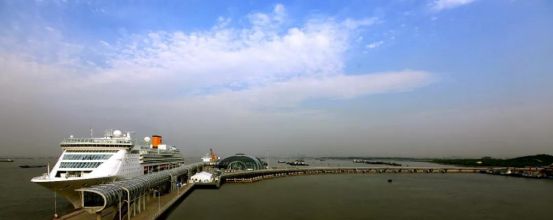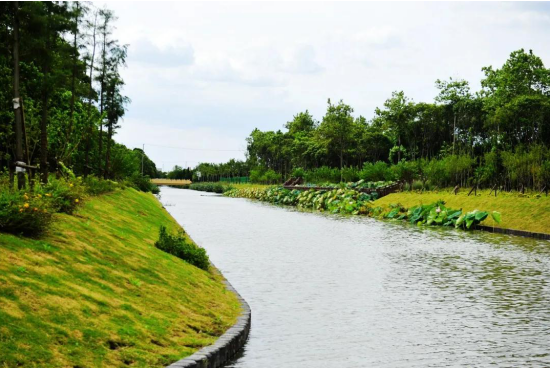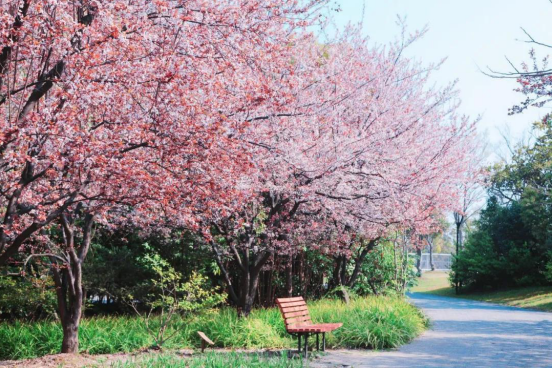Yangtze River Protection, Baoshan Is in Action
Baoshan, adjacent to the mouth of the Yangtze River, is of special ecological importance. With the implementation of the Yangtze River Protection Law, Baoshan District puts into practice General Secretary Xi Jinping’s thought on ecological civilization and implements the new development concept based on the new development stage so as to build a new development pattern and take its ecological protection work to a new level.

Observe the Ecological Red Line, Practice the “Two Mountains” Concept
Chenhang Reservoir, located in Luojing Town, Baoshan District and on the south bank of the Yangtze River estuary, is one of the four centralized drinking water sources in Shanghai. Following the delineation of drinking water source protection zones by the municipal government, Baoshan has strictly observed the ecological red line and risen to challenges. In 2016, Baoshan was the first in Shanghai to complete the closure of water source polluters, with 78 industrial enterprises and livestock and poultry farms in the water source protection zone completely closed; in 2018, interception of rural domestic sewage within the protection zone was completed; in 2019, ecological management of water systems connected to the water source was initiated to systematically improve the regional water ecology; and in 2020, an aquaculture tail water recycling and self-purification system was built to further eliminate the risk of water pollution in the protection zone.

Sanxiangou—Before Remediation

Sanxiangou—After Remediation
Under the concept of “lucid waters and lush mountains are invaluable assets”, Five villages in Luojing Town actively promote the improvement of areas surrounding the water source and jointly boost rural revitalization by developing their characteristic industries, with Tangwan Village focusing on flowers, Haixing Village crabs, Huahong Village rice, Xinlu Village vegetables, and Yangqiao Village steamed cakes. The concerted efforts have turned these villages into beautiful places boasting clear rivers, vast and fertile farmland, lush forests, blooming flowers, and fish ponds, forming a unique landscape at the Yangtze River estuary.

Prioritize Ecology, Restore the Environment
Wusong Paotaiwan Wetland Forest Park lies at the confluence of the Yangtze River and Huangpu River in the east of Baoshan District, bordering Yangtze River to the east and Paotai Mountain to the west. The original site was a mudflat area backfilled with steel slag, and was once a steel yard, parking lot, sand quarry, and a place for scavengers to live, heavily polluting the ecological environment. After years of efforts to restore the ecological environment, in December 2013, the park became a pilot national wetland park. It covers an area of 106.6 hectares, with 64.2 hectares devoted to wetland areas, and stretches for about 2,250 meters along the river bank. The park is rich in biodiversity, with 359 kinds of plants and over 60 kinds of birds. The well-preserved riverside wetlands in the park serve as ideal stopover sites for migratory birds in winter.

The Paotaiwan Park is now a beautiful landscape at the Yangtze River estuary and is very popular with citizens. It has won many awards, including the Silver Award for Shanghai’s Achievements in 30 Years of Reform and Opening-up, China Habitat Environment Award, and Award of Excellence for Landscape Management in the 7th IFLA-APR Awards for Landscape Architecture in 2010, and has been named a national AAAA-level tourist attraction, a national science education base, and a five-star park of Shanghai. To promote urban development in the new era and put into practice General Secretary Xi Jinping’s call for “cities built by the people and for the people”, Baoshan adopts people-centered approaches and focuses on people’s needs. The Paotaiwan Park is thus free of charge since October 1, 2020, with the Wusong waterfront section opening to the public in the same time. Through these efforts, Baoshan is committed to creating a habitable and enjoyable environment where people have a greater sense of gain and live a happier and better life.
Observe the Fishing Ban, Rehabilitate the Yangtze River
The Yangtze River ecosystem is an extremely precious natural resource to Baoshan. As Baoshan has many docks, farmers’ markets, aquatic enterprises and fishing-related catering companies, the implementation of fishing ban in this region is a huge task. Despite great difficulties, the local government has strictly observed the fishing ban, optimized the top-level design, advanced the coordination mechanism and shouldered its front-line responsibilities. In 2016, Baoshan took the lead in completely retrieving and disposing of non-standard fishing boats. In 2018, Baoshan implemented a full fishing ban and stopped the issuance of all types of special fishing licenses, completing its work ahead of schedule. Since 2020, in order to cut off the black industry chain of illegal fishing, transportation and sales of wild aquatic products from the Yangtze River, the Baoshan government has organized a series of crackdowns on illegal fishing, seized illegal fishing gear, carried out inspections of relevant products in circulation, issued notices, and handled 28 illegal fishing-related cases. Currently, with no professional fishermen and fishing boats in sight and illegal fishing and sales of wild fish from the Yangtze River almost eliminated, Baoshan has achieved the goal of clearing the river and the lakes of fishing boats and nets, and made sure that there were no fishermen and no fishing-related production in the region. The 10-year fishing ban is designed to restore the ecological functions of the Yangtze River, the mother river of the Chinese nation, and allow it to regain its vitality.
“Three Lines and One List” to Promote Regional Green Development
In 2020, Shanghai has released its regional ecology and environment management guideline based on the “three lines and one list”, namely environmental quality bottom line, resource utilization upper limit, ecological protection red line, and environmental access list. Baoshan has strictly followed the “three lines and one list” and taken various management and control measures: as for priority protected areas, Baoshan has strengthened environmental improvement and supervision of Chenhang drinking water source protection zone, dealt with enterprises illegally discharging pollutants as stipulated, and carried out daily inspections; as for areas under key management and control, Baoshan has reinforced the supervision of pollutant discharging units in Baoshan Steel Base and Luojing port area, completed the issuance of pollutant discharge permits to key units in the areas, and implemented online monitoring of major discharge outlets as stipulated; as for units under general management and control, Baoshan has implemented classified and graded supervision and investigated illegal pollutant discharging behaviors. By implementing the ecology and environment management measures and staying committed to prioritizing ecological conservation and boosting green development, Baoshan aims to promote comprehensive regional economic and social green transformation and realize harmonious coexistence of man and nature.
Targeted Pollution Treatment to Control the Last Gate for Pollutants to Enter the River
Baoshan has launched a pilot project in the 2-kilometer-long area along the Yangtze River to conduct screening, pollution source tracing and monitoring at 230 outlets. For 11 problematic outlets, the government closed some, merged some and standardized some based on the “one outlet, one policy” principle, which provides experience that can be replicated and promoted and promotes thorough screening and rectification of pollution discharge outlets in the entire district.
Establish a Joint Pollution Control Mechanism
Administrative departments of ecology and environment, water affairs, transportation, agriculture and rural affairs, and landscaping and city appearance at both the district and sub-district (park) levels, together with Baosteel, Huaneng Power Plant, SIPG and other large enterprises in Baoshan, join their efforts in pollution control.
Identify Pollution Sources Through Various Measures
The Baoshan government has explored multiple methods in air, on the ground and waterways to thoroughly examine the pollutant discharge outlets, including on-site survey, monitoring by both manned and unmanned boats, and aerial survey by drones. Building on the analysis of the surrounding environment of outlets and the pipe network using remote sensing technology and geographic information analysis, sources of pollution have been traced by carrying out field survey and for knotty outlets, by using pipeline robots, quick view inspection and the tracer method.
Serious and Targeted Rectification
For typical problems with outlets found in pilot pollution tracing concerning industrial sewage, urban communities, rural homestead and mixed discharge of rain water and sewage, the Ecology and Environment Bureau and Water Affairs Bureau of Baoshan District organized relevant sub-district agencies and parks to formulate plans and immediately rectify the problems.
Explore a Refined Management Mechanism
The Baoshan government is currently building a discharge outlet management platform, setting up a database with files of outlets, rivers, and towns, and exploring a long-term refined outlet management mechanism featuring clear responsibilities, reasonable layout and standardized management, so as to effectively manage and control discharge of pollutants into the rivers and improve water ecology and quality.
Strictest Law Enforcement to Guard the Yangtze River
With new prohibitions, new punishments and supervision measures, and fines of up to 5 million yuan for violations, the Yangtze River Protection Law provides a legal weapon for the ecological protection of the Yangtze River. Competent authorities of Baoshan District, in conjunction with Yangtze River public security organs and Shanghai Maritime Safety Administration, resolutely implement the law, perform their duties, work in close cooperation, and strengthen law enforcement coordination to protect and restore the Yangtze River. Recently, the Shanghai Branch of the Yangtze River Shipping Public Security Bureau, together with water affairs departments at the municipal and district levels handled 4 illegal sand mining cases, a targeted crackdown on and a powerful deterrent against illegal acts damaging the ecological environment of the Yangtze River.
On the very first day the Yangtze River Protection Law took effect, the Shanghai Branch of the Yangtze River Shipping Public Security Bureau, Ecology and Environment Bureau and Water Affair Bureau of Baoshan District conducted operation on joint law enforcement along the Yangtze River and publicity and implementation of the Yangtze River Protection Law. The coordinating departments patrolled the waters around Baoshan on the south bank of the Yangtze River, inspected the shoreline utilization management and discharge of pollutants at the outlets, discussed resources under supervision by each department, identified the priority of law enforcement work at the current stage, explored the mechanism of joint case handling and case transfer regarding acts such as illegal pollutant discharge, illegal occupation of shorelines and illegal sand mining, which laid a foundation for the regular joint cooperation in the future. The strictest law enforcement is aimed at punishing various illegal and criminal acts damaging the ecological environment of the Yangtze River, safeguarding the Yangtze River ecology and restoring clean water and beautiful shores.

宝山汇APP

上海宝山微信

上海宝山微博